Menu
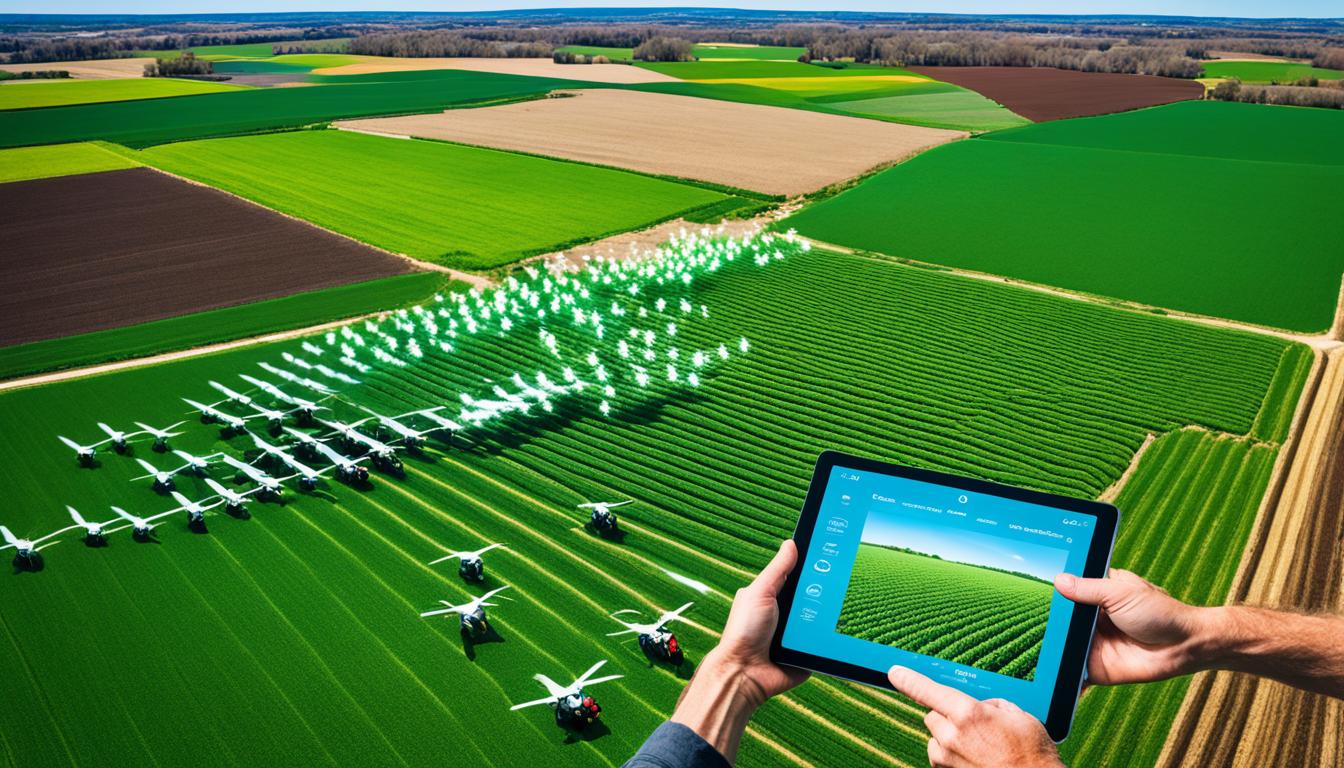
By 2050, our planet will hold a massive 10 billion people. This will greatly increase the need for more food. The agriculture sector must find ways to grow more crops. It is clear that machine learning in agriculture will be key. It is predicted to grow from a USD 1.7 billion market in 2023 to USD 4.7 billion by 2028.
Machine learning in agriculture is changing the way farming works. It is making farming more sustainable and productive. For example, it uses computer vision to spot weeds accurately. This lets farmers apply herbicides exactly where needed. Also, machine learning can spot crop diseases early. This helps protect the amount and quality of harvests.
Machine learning also helps by predicting when to harvest crops. This makes decision-making easier. In breeding, AI speeds up the search for traits that help crops. This shows how using AI in farming improves how we work, boosting efficiency and sustainability.
AI is changing how we farm, making agriculture more efficient and based on data. Thanks to years of experience in farming, AI brings strong quality control. This change is making farming better and bridging the gap between old and new ways.
AI is boosting how we grow food by making everything work better. It helps predict how much food we’ll get, find plant diseases, and control weeds. Using technology that looks at pictures, AI can spot weeds right away. This helps farmers deal with them faster, making farming more efficient.
Now, big data is giving farmers the power to decide based on what might happen. AI checks the soil, recognises crops, and makes sure the food is good quality. With AI’s help, farm teams decide how to make more money smartly. They also make sure they follow the rules in farming.
The main uses of AI in farming—predicting yields, finding diseases and weeds, and checking crop quality—show how powerful AI is. Predicting how much we’ll harvest is tough, but AI makes it better, helping match what the market needs. It also speeds up getting the food ready for sale.
| Application Area | Key Benefit |
|---|---|
| Yield Prediction | Accurate harvest timings |
| Disease Detection | Early diagnosis and management |
| Weed Detection | Targeted and precise weed control |
| Crop Recognition | Efficient crop management |
| Crop Quality Assessment | Faster processing and market readiness |
Companies like Aibono, VineView, and others are driving AI forward in farming. With every new idea, farming moves towards being more efficient and sustainable. This helps us see farming not just for survival, but for a better future.
Precision agriculture uses smart technology to make farming better. With machine learning, it’s getting even more advanced. By 2027, the precision agriculture market could be worth $12.9 billion. This money shows how important machine learning is for big crop harvests and saving resources.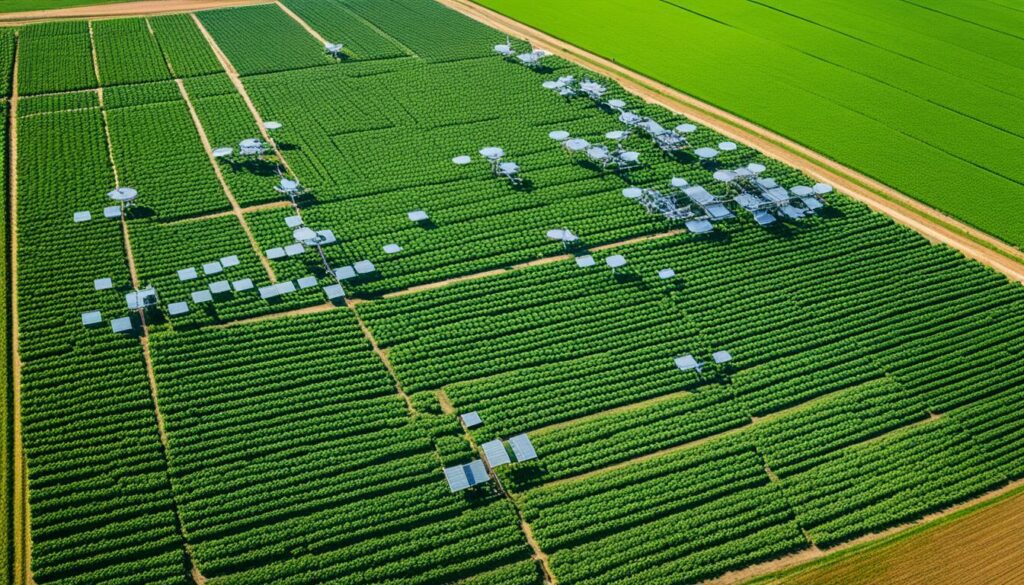
Thanks to smart precision farming, we can grow crops better. Machine learning looks at a lot of data to find the best ways. Vineyards, for example, saw their grape harvests go up by a fifth. At the same time, they used less water.
This shows how using machine learning can really boost what farmers get from their fields. Plus, with the help of machines like sensors and drones, farmers can see what their crops need in real-time. This means they can give the perfect care, when and where it’s needed.
Looking after resources is key in farming. Precision agriculture ML helps use water, fertilisers, and other things better. This isn’t just good for the planet; it also saves money. Countries like the US, Canada, and parts of Europe are already seeing the benefits. They’re managing their farm resources a lot smarter.
By 2025, half the work on farms may be done by machines. This shows how important machine learning is becoming in agriculture.
AI and machine learning stop resources from being wasted. They give farmers the best tips to care for their land. As we use more of these smart technologies, farming will become more efficient and eco-friendly.
Google’s DeepMind showed that machine learning is great outside of farming too. It predicted protein shapes very well, proving how powerful machine learning can be.
The world’s population could reach 9.7 billion by 2050. This number may go up to 10.9 billion by 2100. To feed everyone, we need more food. Yet, we face a big challenge: crop yield grows slowly, by just 1.3% each year. Also, 20% to 40% of our crops are lost yearly due to diseases and insects. This loss costs the world a lot of money, around $220 billion for diseases and $70 billion for insects. On top of that, we use a lot of pesticides which can harm us and the environment.
Thankfully, machine learning in agriculture is helping. It aids in the early and accurate detection of crop diseases. This means farmers can spot problems fast and take the right action. It allows for treatments to be used only where they’re needed. Thus, we can reduce pesticide use and keep the environment healthier.
One key benefit of using AI in farming is spotting issues early. Technologies like CNN and KNN help identify diseases swiftly. This quick detection means farmers can stop outbreaks before they become major. This helps in keeping crop yields high and of good quality.
AI also helps cut down on pesticide use. With more pests, we’ve been using more pesticides. But, smart tools can give farmers specific health information about their crops. Armed with this knowledge, farmers can apply treatments only where necessary. This approach lowers the overall use of pesticides. It’s good for our planet and for people who eat the crops.
Our food needs are growing, and so is the impact of climate change on farming. Climate changes could increase crop losses by up to 25% per degree of warming. That’s why we need to use AI for early disease detection and smart pesticide management. These new methods are changing agriculture for the better. They help improve our food, protect the environment, and support sustainable farming.
Machine learning is changing how we deal with weeds in farming. It brings new ways to fight unwanted plants that are both accurate and efficient. This is a big improvement over the old method of spraying everywhere. The new AI weed tech can pinpoint which weeds are which and only spray them.
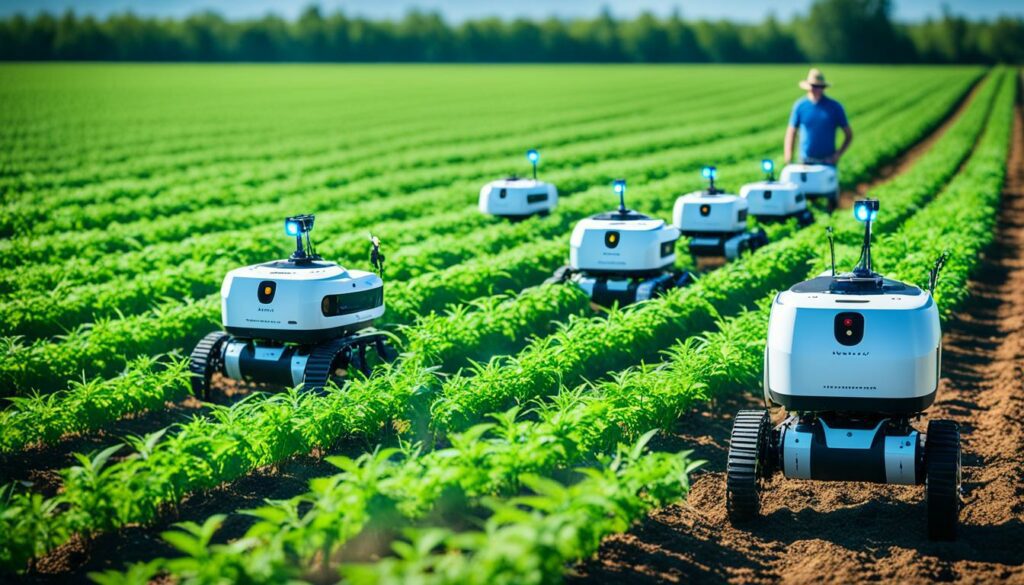
With better technology for spotting weeds, like using CNNs in image processing, we can tell the difference between crops and weeds very well. Using models like PyTorch, we can cut down on herbicide use by as much as 40%. This helps the environment and supports farming that cares for the planet.
There are big savings in money, too. In Australia, just controlling weeds on grain farms costs about USD 2.6 billion a year, with another USD 0.7 billion in lost harvests. Smart weed tech could trim these costs a lot. Plus, the global pesticide market could spend less of its USD 100 billion on weed control at the same time.
More and more, people are choosing to use machines for weed control over people because it’s cheaper and better for health and the planet. For example, AI drones can pick out weeds in rice fields with 85.58% to 92.41% accuracy, using learning algorithms. This progress shows we’re headed towards farming where accuracy, saving money, and taking care of the world matter most.
All these new technologies show us a different, forward-looking approach to fighting weeds. AI weed management is becoming key as we head towards having nine billion people by 2050. We will need to grow more food. Using smart weed control helps us do this without harming the environment.
Using machine learning, we can predict crop yields better. These models look at both the environment and the plant’s features. They help us understand how things like the weather and genetics affect crops.
It’s vital to know how the environment affects crops. Smart farming aims to grow more food using less water, nutrients, and energy. IoT sensors help by keeping an eye on the soil’s moisture and temperature. This information is key for knowing the best times to plant, water, and harvest.
Many environmental factors come into play when predicting crop yields. Things like soil moisture, temperature changes, and rainfall matter a lot. By looking at lots of data from IoT sensors, we can make better predictions. This helps farmers make choices that are good for the environment and their crops.
Machine learning algorithms in agriculture can analyse data from different sources to predict crop growth, optimise farming practices, and enhance produce quality.
Studying plant features is crucial for better yield predictions. Machine learning helps us combine information about different plant types and their genetics. This tells us the best times to plant and harvest. Details like soil quality, crop moisture, and how much drought crops can handle all improve our predictions.
| Factor | Importance |
|---|---|
| Soil Moisture | High |
| Drought Stress | Medium |
| Genetic Data | High |
| Temperature | Medium |
Showing how to use crop models like APSIM can lower prediction mistakes. It means we can predict yields more accurately. Combining all these factors lets us farm better. This means more food and more profit.
Selective breeding in agriculture is vital and has been for many years. It allows farmers to grow crops that have useful qualities. Now, with AI and technology, this process is changing. The AI market for farming is set to reach $11.2 billion by 2027. This will happen with a growth of 25.4% each year from 2020.
Farming has become a lot more efficient thanks to machine learning and AI. They help select the best genetic traits with accuracy. Agricultural robots can plant, harvest, and weed by using AI. This speeds up the breeding of new crops and makes them better.
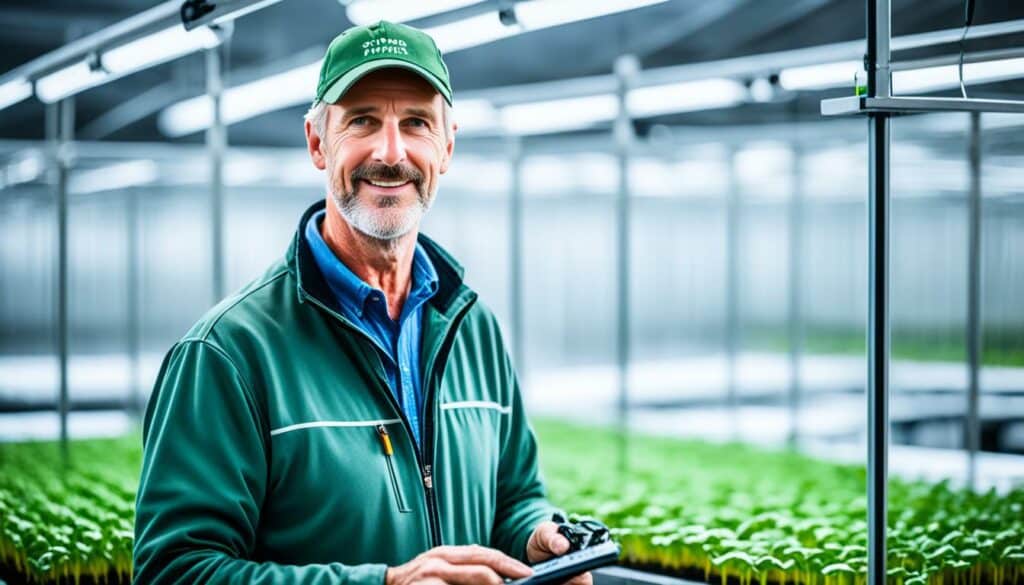
Pattern recognition AI is a big step forward in selective breeding. It’s very good at analysing plant features. This makes finding the best traits quicker and more accurate.
AgroScout is one company using AI for spotting plant diseases early. This saves crops. Also, deep learning is used to make plants better suited for farming in many ways.
Breeding 4.0 combines big data, AI, and biotech. Before, choosing the right plants was slow and not always accurate. Now, with AI’s help, things are better. This means we can grow crops that give more food, resist diseases, and are good for the future of farming.
In today’s world, farms need to produce more food for a growing global population. By 2050, we expect to have 10 billion people needing to be fed. So, keeping our soil healthy is vital. Smart farming tech is now coming to the rescue. It helps manage nutrients and gathers real-time data to keep the soil fertile and crops growing well.
Managing soil nutrients well is key to getting good crops. Thanks to AI, farmers can now keep a close eye on their soil. They can make sure their plants get exactly what they need, when they need it. This means better crops, less waste, and a boost for the soil’s long-term health.
Smart tech can check the soil’s pH, temperature, and more on the spot. This kind of data helps farmers act fast when something’s off. With AI in farming growing quickly, these tech tools are changing how we farm for the better.
These tools do a lot. They can find leaks in irrigation and even predict how well a crop will do. Drones, sensors, and other smart devices gather data as they fly over farms. This information lets farmers be smarter about using resources and growing more food.
The global population is expected to hit 10 billion by 2050. This puts a lot of pressure on farming to produce more food. Machine learning is changing farming for the better. It’s bringing new tools like smart farming and AI-driven equipment.
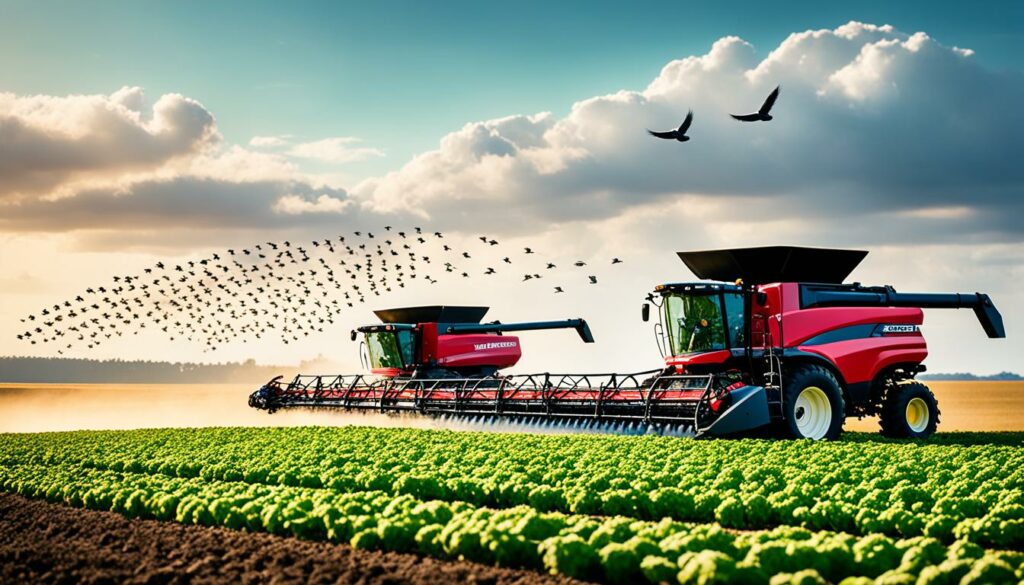
Machine learning is making crop management smarter. It’s introducing advanced tools to oversee and boost farming processes. This shift leads to the use of autonomous tractors and harvesters. This means more productivity and less need for manual work. The AI in agriculture market is set to jump from USD 1.7 billion in 2023 to USD 4.7 billion by 2028. This shows how fast automation is growing in farming.
AI-powered farming tools are becoming really efficient and accurate. They can do tasks like tracking wheat growth or finding ripen tomatoes better than humans could. AI drones are precise in applying pesticides. This helps reduce the need for harmful chemicals on plants.
The table below highlights some key applications and benefits of AI in agriculture:
| Application | Benefits |
|---|---|
| Crop Disease Detection | Early diagnosis, reducing pesticide use |
| Yield Prediction | Accurate forecasts, better planning |
| Weed Control | Selective targeting, reduced herbicide use |
| Livestock Health Monitoring | Remote monitoring, improved productivity |
| Irrigation Management | Optimised water use, sustainable practices |
Machine learning makes farming more efficient and sustainable. By using smart farming techniques, AI is changing the way we grow crops. This ensures that the agriculture sector can keep up with demand in the future. It does this while being mindful of the environment and using resources effectively.
Computer vision is changing how we spot pests in farming. It’s making crop protection smarter with its accurate identification of pests and plant diseases. For farmers today, these high-tech tools mean they can act faster to protect their crops. We will explore how these tools work to find and fight insects, stopping them from hurting our food.
Computer vision is amazing at spotting insects. Studies show it’s as accurate as 90% in finding pests, essential where older methods struggle. In fact, in the toughest spots, it works perfectly all the time. Systems like the genetic algorithm-based DL can tell pests apart with an 85% success rate.
Using CNNs, we can spot pests from images with up to 87% accuracy. A model called HGS-DCNN is even better at spotting them no matter where they are. It boosts how well we find pests, making detection more effective.
Stopping damage to crops is key for farming to thrive. DL tech is making a big difference by spotting insects early. It’s using satellites and other tools to map out problems with 95% accuracy. This is crucial for large areas of crops.
There are models that are almost 90% good at picking pests, even in complex scenes. And methods to check plant health are now 92% accurate, keeping crops strong. By combining these with AI, new smart farming systems are excellent at pest control, hitting an 88% success rate.
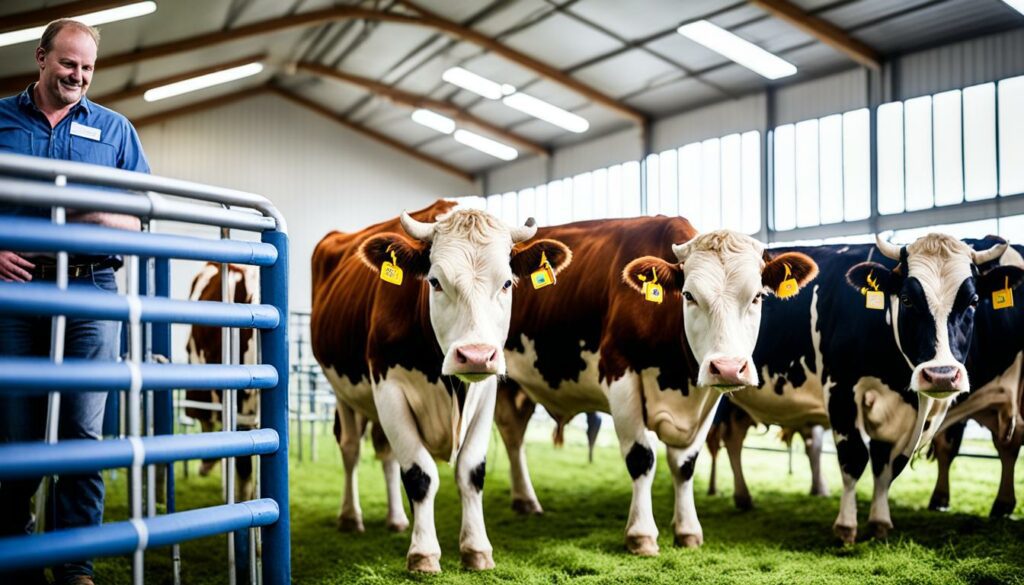
AI is changing how we look after animals. It’s making big improvements in how we watch over livestock. This new technology is set to increase productivity, look after animals better, and make things run smoother.
One key tool in this change is drones with cameras. They can check on animals from above, looking for illness or injuries. This keeps the animals safe. Also, there’s a tech that watches animals all the time, making sure they get the right amount of food and checking their behaviour.
Data labelling is very important for AI in farming. It helps the computers learn about farming animals in a smart way. This job is made easier by tools like LabelGPT, which help make the data perfect for the AI to use. That way, the AI systems can be trusted.
This technology is also great at spotting diseases early. It uses smart programs to find health problems before they become big issues. This means farmers can act quickly to keep their animals healthy and avoid losing too many.
AI can also help with what the animals eat. It changes their diets to keep them in top shape for growth. Plus, by being careful with the animals’ food, we can help the environment too.
AI is also good at counting animals fast and accurately. Drones can do this without any mistakes. This makes looking after lots of animals much easier.
By using AI, we can keep track of animals and know exactly where they are. This makes sure they are safe. Also, looking at the animals’ genes helps farmers breed better stock, improving the quality of livestock.
In the end, AI is making farming smarter. It’s helping farmers and ranchers look after their animals better. This means we can have more food that’s made in a way that’s good for the planet.
AI algorithms have changed how we make irrigation systems better. They use real-time data to give plants exactly the water they need. This new tech helps in using water better, making farming more sustainable and saving water.
AI is being used to manage irrigation through smart sensors. These sensors check how much water the soil has and tell us quickly. Because of this, farms can use water more efficiently. Studies show we can use 25% less water with these systems, which is great news for the environment.
Precision agriculture gets a boost from AI-powered systems. These systems keep an eye on the soil, weather, and what the plants need. This helps farms grow 20 to 30% more crops and saves on energy. The move from old sprinklers to smart systems is a big change for the better.
Using AI for irrigation also means less work for people. It makes managing water on farms much easier, cutting down on manual work. As a result, farmers can be more efficient without having to do everything themselves.
| Aspect | Benefit |
|---|---|
| Water Usage | Reduced by up to 25% |
| Crop Yields | Increased by 20 to 30% |
| Energy Consumption | Decrease due to efficient water management |
| Labour Requirements | Reduced with automation |
AI in irrigation is key to managing water better in farming. It can help grow more food, use less water, and care for the environment. By improving how we water crops, AI is making farming greener and more efficient.
In farming today, autonomous farm machinery with sensory data is a game-changer. It helps us track weather and soil moisture better.
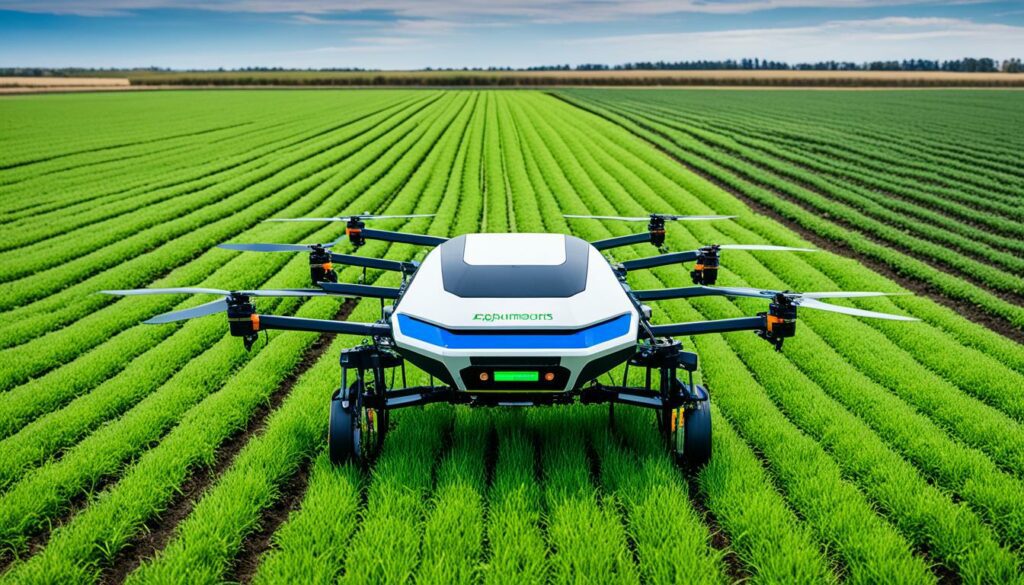
Weather monitoring AI makes farm tools adjust instantly to weather changes. With weather more unpredictable, these systems help handle unexpected problems. They could save American farmers up to $3 billion by avoiding losses from equipment issues.
Modern soil moisture analytics work with self-driven farm tools to keep the soil at the right moisture. These tools give very precise measures to ensure crops get just the water they need. This can boost crop growth and efficiency, fighting against the 53% loss in crops from machinery problems.
The link between sensory data in farming and self-driven machines marks a new chapter in agriculture. It gets farmers ready to tackle today’s challenges. And it shields their income too.
Nowadays, using agriculture data analytics is key to boosting farm yields and making crop management better. It does this by putting all farm operations in one place and using software to do some jobs. This has made farms more efficient and productive.
A type of software called Agriculture ERP brings together many parts of farming like managing crops and stock, keeping track of everything, handling money, managing the people who work there, and lots more. This helps in working better and smarter by using data well and doing some tasks automatically. This can make farms perform much better.
Also, new tech like AI and machine learning help to get more crops and run farms better. Using predictive analytics, farmers can guess how much they’ll grow by looking at past data, weather, the land, and more. This helps with using resources well and managing money, which means more profit for the farm.
AI and clever software also warn against bugs and bad weather. Thanks to these smart techs, farmers can spot pests and diseases early and deal with them fast. This cuts down on crop loss and reduces the need to use harmful chemicals. By doing this, farms can be kinder to the environment, save water, and use fewer chemicals.
Next, there are technologies for farming precisely, which are backed by machine learning. These technologies use data from things like satellites, soil checks, and weather forecasts to manage fields better, cut waste, and grow more produce. They also help with getting products to the market, managing stock, and moving things around. This means they can react faster to what customers want.
Finally, making good use of agriculture data analytics and smart forecasts is a big change in farming. Farmers who work with these advanced tools can be smarter in their choices, run their farms better, and aim for success and sustainability in the changing agricultural world.
AI is making big changes in farming, saving a lot of money. It helps farms use their resources better and cuts costs. These tools target how resources are used, making farms more efficient.
AI helps farms use less resources, saving money. Drones with AI check on cows from a distance, making care more precise. This reduces waste. Smart irrigation systems also play a big role. They find leaks and adjust water without any human help. This saves water and stops crops from getting damaged.
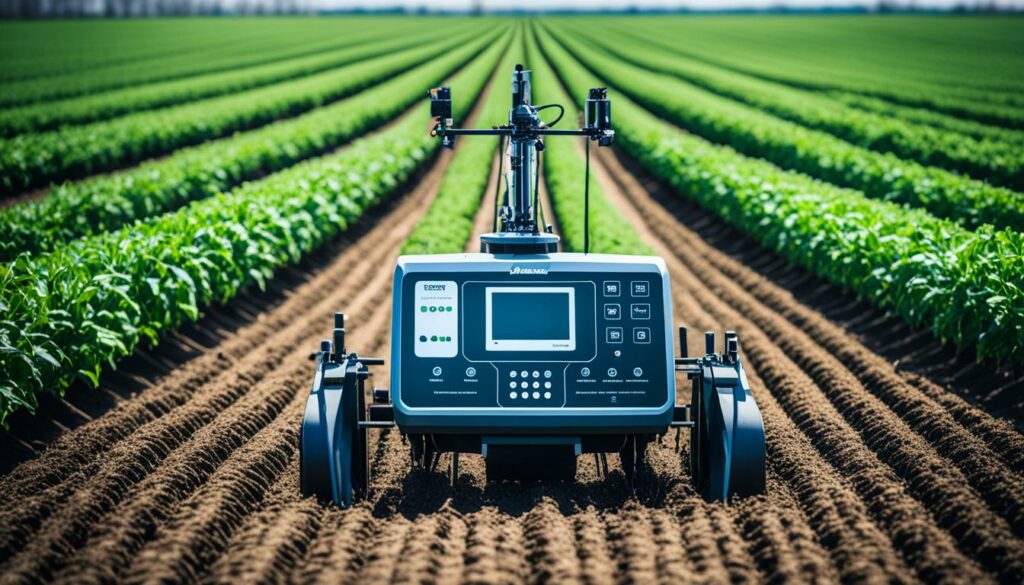
AI isn’t just for checking on animals. It can help spot crop diseases too, making farming more efficient. Tools like yield mapping and disease detection are very accurate. They help plan crops and treat diseases without using too many chemicals.
AI is great at making farming cheaper. For example, AI drones are changing how we spray crops. They’re more accurate, using less pesticides. This saves money and is better for the environment.
Farms are also using more renewable energy. Thanks to AI, these solutions are even more efficient. Some farms are using up to 15% less energy. This is a great step towards greener farming.
Greenhouses and vertical farms have IoT devices that watch energy and conditions closely. They send info to the cloud for farmers to see. This helps them make smart, money-saving choices. It also makes farms less harmful to the planet.
To sum up, AI is changing farming for the better. It’s saving money and making farming more sustainable. By cutting down on resource use and being smarter with costs, AI is reshaping agriculture.
The future of machine learning in farming shows huge promise. By 2050, we will need to feed 10 billion people. This puts a lot of pressure on farming to produce more. Machine learning is key to this, helping to meet these demands.
There are several new agricultural trends thanks to machine learning. The market for AI in farming is expected to grow a lot. So, from 2023 to 2028, it might jump to USD 4.7 billion.
Tools like driverless tractors and AI robots for picking crops are here to help. They overcome labour shortages and make farming more efficient. AI also helps with predicting the weather, finding out what the market needs, and figuring out the best times to plant and harvest.
The long-term benefits of ML in farming are huge. By using ML and precision farming, farms can grow more with less waste. This means they can take better care of their crops by using less water, fertiliser, and pesticides.
Automation makes things even better. It uses resources more wisely, cutting out the things farmers don’t need. For example, AI helps farmers know where they should plant more accurately. And it helps spot pests and control diseases better.
These improvements are not just dreams; they’re becoming real:
| Application | Advantages |
|---|---|
| Predictive Analytics | Improves data processing, market forecasting, and optimises sowing/harvesting. |
| Precision Agriculture | Maximises yields with fewer resources, personalised crop care in real-time. |
| Automation | Addresses labour shortages, ensures efficient and accurate farming operations. |
Introducing machine learning to farming makes our practices smarter and more efficient. For example, it has helped us detect disease quickly in salmon farms. This shows how AI can change agriculture for the better.
It has also improved our drought forecasting with the use of climate data. This helps us protect our crops better and use water more wisely. This is important because most of the world’s water is used in farming.
Machine learning does a lot in agriculture. It looks after soil health and makes farming advice more accurate. It also helps keep an eye on animals, spotting diseases early. This leads to healthier animals and better farming.
Deep learning is also great for checking soil moisture in the U.S. across the continent. It’s helping with managing crops, predicting their yield and quality. Above all, it’s aiding in making crops with better characteristics by choosing the best ones through ML.
To sum up, AI and machine learning are shaping the future of farming. They’re making our food sources more certain and our work more sustainable. These new approaches promise a farming sector that can survive future challenges. The future of farming powered by smart technologies looks bright, promising a new chapter of farming greatness.
Machine learning is transforming agriculture. It promotes sustainability and boosts productivity. It achieves this through precise methods. These methods include targeted herbicide treatments and early disease diagnosis.
AI makes farming more efficient. It supports quality control and ensures that farms meet standards. It also helps track products. Additionally, it uses data analysis for making smart decisions. This covers everything from checking soil to deciding the best time to harvest.
With machine learning, precision agriculture is becoming more efficient. It helps maximise crop yields by offering accurate, real-time data. This data handles farm resources better. It also provides personalised care for crops, saving important resources.
Machine learning tools spot crop diseases early. They do this by looking for specific markers of disease. Farmers can then treat only the affected areas. This reduces pesticide use and helps protect crop health.
Machine learning is vital for targeting and managing weeds. It helps cut down on herbicides. This approach is better for the environment. It also promotes healthier crops.
Machine learning makes yield predictions more accurate. It considers many factors, such as the environment and plant characteristics. These models help predict crop results better. They give advice on the best planting and harvest times.
Using AI, selective breeding speeds up the development of wanted plant traits. It navigates complex genetic interactions. This process significantly boosts the efficiency and success of breeding, better than before.
Smart farming technology checks on soil health in real time. It collects data constantly. This allows farmers to control nutrient levels. They can do this to keep the soil fertile and productive.
Machine learning has brought more automation to farms. It uses AI in machines. This helps increase productivity. It also lessens the need for human work. Plus, it ensures precise management of crops.
Computer vision is great for finding pests. It spots insects accurately. This helps farmers protect their crops. They can act quickly and precisely to safeguard their harvests.
AI in livestock includes cameras and wearables. These systems watch over the animals. They analyse behaviour and health signs. This information is vital for managing the herd and improving productivity.
AI makes irrigation much better. It uses real-time data. This way, crops get just the water they need. It saves water and supports sustainable farming.
Sensory data helps autonomous machines react to conditions right away. They adjust to weather and soil moisture as they happen. This leads to efficient and accurate crop management.
Data analytics help farmers understand crop growth factors better. They provide clear advice on crop care. This maximises production.
AI reduces the use of resources and cuts input costs. It applies farming inputs accurately. This results in big savings and better profits for farmers.
The future looks bright for machine learning in agriculture. It’s all about sustainability and efficiency. Over time, it will increase productivity and improve crop quality. It will also help farms adapt to changes in the climate.